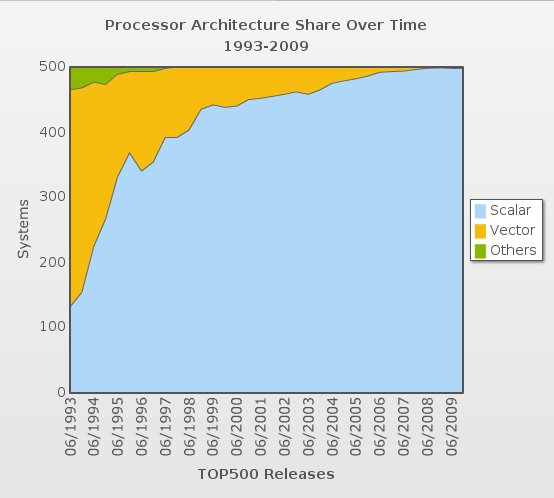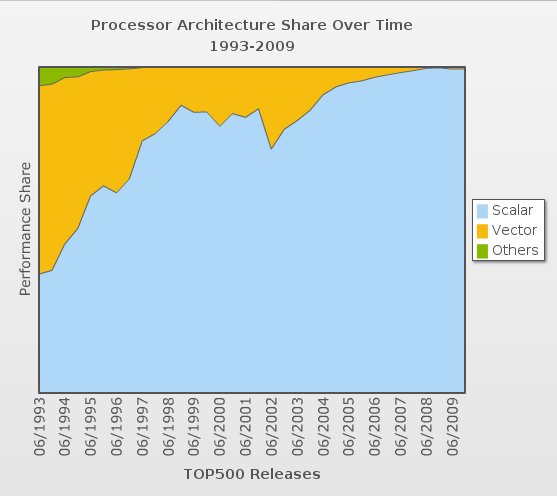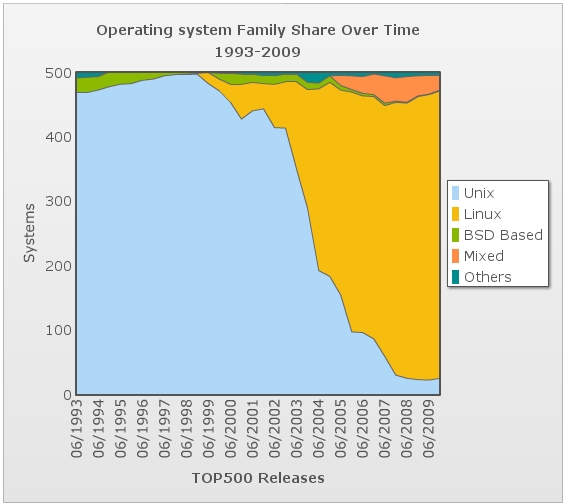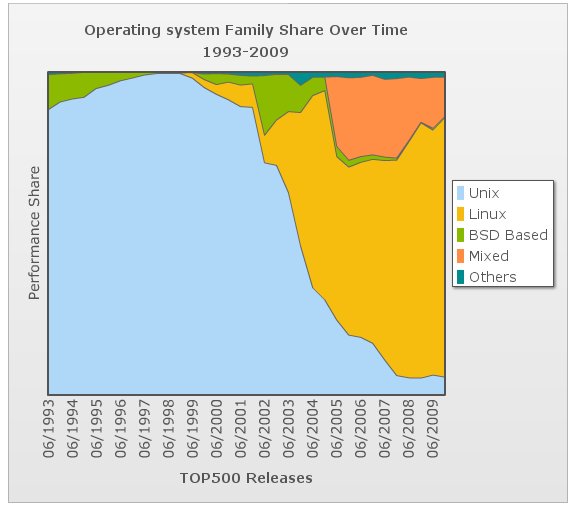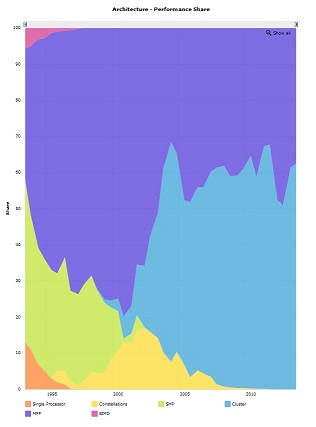CSC/ECE 506 Spring 2010/ch1 lm
A supercomputer is a computer that is at the frontline of current processing capacity, particularly speed of calculation. Supercomputers were introduced in the 1960s and were designed primarily by Seymour Cray at Control Data Corporation (CDC), and led the market into the 1970s until Cray left to form his own company, Cray Research. He then took over the supercomputer market with his new designs, holding the top spot in supercomputing for five years (1985–1990). In the 1980s a large number of smaller competitors entered the market, in parallel to the creation of the minicomputer market a decade earlier, but many of these disappeared in the mid-1990s "supercomputer market crash".
Today, supercomputers are typically one-of-a-kind custom designs produced by "traditional" companies such as Cray, IBM and Hewlett-Packard, who had purchased many of the 1980s companies to gain their experience. As of 7/2009, the Cray Jaguar is the fastest supercomputer in the world.
The term supercomputer itself is rather fluid, and today's supercomputer tends to become tomorrow's ordinary computer. CDC's early machines were simply very fast scalar processors, some ten times the speed of the fastest machines offered by other companies. In the 1970s most supercomputers were dedicated to running a vector processor, and many of the newer players developed their own such processors at a lower price to enter the market. The early and mid-1980s saw machines with a modest number of vector processors working in parallel to become the standard. Typical numbers of processors were in the range of four to sixteen. In the later 1980s and 1990s, attention turned from vector processors to massive parallel computing|parallel processing systems with thousands of "ordinary" central processing unit|CPUs, some being commercial off-the-shelf|off the shelf units and others being custom designs. Today, parallel designs are based on "off the shelf" server-class microprocessors, such as the PowerPC, Opteron, or Xeon, and most modern supercomputers are now highly-tuned computer clusters using commodity processors combined with custom interconnects.
Supercomputers are used for highly calculation-intensive tasks such as problems involving quantum physics, weather forecasting, climate research, computational chemistry|molecular modeling (computing the structures and properties of chemical compounds, biological macromolecules, polymers, and crystals), physical simulations (such as simulation of airplanes in wind tunnels, simulation of the detonation of nuclear weapons, and research into nuclear fusion).
Timeline of supercomputers
This is a list of the record-holders for fastest general-purpose supercomputer in the world, and the year each one set the record. For entries prior to 1993, this list refers to various sources CDC timeline at Computer History Museum. From 1993 to present, the list reflects the Top500 listing Directory page for Top500 lists. Result for each list since June 1993, and the "Peak speed" is given as the "Rmax" rating.
| Year | Supercomputer | Peak speed (Rmax) |
Location |
|---|---|---|---|
| 1993 | CM-5/1024 | 59.7 GFLOPS | DoE-Los Alamos National Laboratory; National Security Agency |
| Fujitsu Numerical Wind Tunnel | 124.50 GFLOPS | National Aerospace Laboratory, Tokyo, Japan | |
| Paragon XP/S 140 | 143.40 GFLOPS | DoE-Sandia National Laboratories, New Mexico, United States|USA | |
| 1994 | Fujitsu Numerical Wind Tunnel | 170.40 GFLOPS | National Aerospace Laboratory, Tokyo, Japan |
| 1996 | Hitachi SR2201/1024 | 220.4 GFLOPS | University of Tokyo, Japan |
| Hitachi/Tsukuba CP-PACS/2048 | 368.2 GFLOPS | Center for Computational Physics, University of Tsukuba, Tsukuba, Japan | |
| 1997 | Intel ASCI Red/9152 | 1.338 TFLOPS | Sandia National Laboratories|DoE-Sandia National Laboratories, New Mexico, United States|USA |
| 1999 | Intel ASCI Red/9632 | 2.3796 TFLOPS | |
| 2000 | IBM ASCI White | 7.226 TFLOPS | DoE-Lawrence Livermore National Laboratory, California, United States|USA |
| 2002 | NEC Earth Simulator | 35.86 TFLOPS | Earth Simulator Center, Yokohama, Japan |
| 2004 | IBM Blue Gene|Blue Gene/L | 70.72 TFLOPS | DoE/IBM|IBM Rochester, Minnesota, United States|USA |
| 2005 | 136.8 TFLOPS | United States Department of Energy|DoE/United States National Nuclear Security Administration|U.S. National Nuclear Security Administration, Lawrence Livermore National Laboratory, California, United States|USA | |
| 280.6 TFLOPS | |||
| 2007 | 478.2 TFLOPS | ||
| 2008 | IBM IBM Roadrunner|Roadrunner | 1.026 PFLOPS | Los Alamos National Laboratory|DoE-Los Alamos National Laboratory, New Mexico, United States|USA |
| 1.105 PFLOPS | |||
| 2009 | Jaguar | 1.759 PFLOPS | DoE-Oak Ridge National Laboratory, Tennessee, United States|USA |
Processors
Processor Architecture
For building Super computers, the trend that seems to emerge is that most new systems look as minor variations on the same theme: clusters of RISC-based Symmetric Multi-Processing (SMP) nodes which in turn are connected by a fast network. Consider this as a natural architectural evolution. The availability of relatively low-cost (RISC) processors and network products to connect these processors together with standardised communication software has stimulated the building of home-brew clusters computers as an alternative to complete systems offered by vendors.
Looking at the following two figures from TOP500 website, we could see an obvious trend of scalar processor architecture over vector architecture.
Processor Family
Number of Processors
Operating Systems
Operating Systems Family
Supercomputer use various of operating systems. The operating system of one specific supercomputer depends on the vendor of it. Until the early-to-mid-1980s, supercomputers usually sacrificed instruction set compatibility and code portability for performance (processing and memory access speed). For the most part, supercomputers to this time (unlike high-end mainframes) had vastly different operating systems. The Cray-1 alone had at least six different proprietary OSs largely unknown to the general computing community. In similar manner, different and incompatible vectorizing and parallelizing compilers for Fortran existed. This trend would have continued with the ETA-10 were it not for the initial instruction set compatibility between the Cray-1 and the Cray X-MP, and the adoption of computer system's such as Cray's Unicos, or Linux.
From the statistics of top500, before the 21st century almost all the OS fall into "Unix" family, while after year 2000 more and more Linux branches are adopted into supercomputers. In the 2009/11 list, 446 out of 500 supercomputers at the top were using their own distribution of Linux. When we list the OS for each of the top 20 supercomputers, the result for Linux is very impressive:
19 of the top 20 supercomputers in the world are running some form of Linux.
And if you just look at the top 10, ALL of them use Linux. Looking at the list, it becomes clear that prominent supercomputer vendors such as Cray, IBM and SGI have wholeheartedly embraced Linux. In a few cases Linux coexists with a lightweight kernel running on the compute nodes (the part of the supercomputer that performs the actual calculations), but often even these lightweight kernels are based on Linux. Cray, for example, has a modified version of Linux they call CNL (Compute Node Linux).
IBM AIX
AIX (Advanced Interactive eXecutive) is the name given to a series of proprietary operating systems sold by IBM for several of its computer system platforms, based on UNIX System V with 4.3BSD-compatible command and programming interface extensions. AIX runs on 32-bit or 64-bit IBM POWER or PowerPC CPUs (depending on version) and can address up to 32 terabytes (TB) of random access memory. The JFS2 file system—first introduced by IBM as part of AIX—allows computer files and partitions over 4 petabytes in size.
Linux Family
SuSE Linux Enterprise Server Family
SLES has been developed based on SUSE Linux. It was first released on 31 October 2000 as a version for IBM S/390 mainframe machines. In December 2000, the first enterprise client (Telia) was made public. In April 2001, the first SLES for x86 was released. SLES version 9 was released in August 2004; SUSE Linux Enterprise Server 10 was released in July 2006; SUSE Linux Enterprise Server 11 was released on March 24, 2009. All of them are supported by the major hardware vendors—IBM, HP, Sun Microsystems, Dell, SGI, Lenovo, and Fujitsu Siemens Computers.
Redhat Enterprise/CentOS
Redhat Enterprise along with CentOS are adopted in some vendors' platform. Red Hat Enterprise Linux (RHEL) is a Linux distribution produced by Red Hat and targeted toward the commercial market, including mainframes. CentOS is a community-supported, free and open source operating system based on Red Hat Enterprise Linux.
UNICOS
UNICOS is the name of a range of Unix-like operating system variants developed by Cray for its supercomputers. UNICOS is the successor of the Cray Operating System (COS). It provides network clustering and source code compatibility layers for some other Unixes. UNICOS was originally introduced in 1985 with the Cray-2 system and later ported to other Cray models. The original UNICOS was based on UNIX System V Release 2, and had numerous BSD features (e.g., networking and file system enhancements) added to it.
UNICOS dominated on supercomputer in 1993 in the sense that 188 out of 500 supercomputers then were running UNICOS. Of course one of the reason is that Cray Inc. was the largest supercomputer vendor at that time(40% supercomputers were from Cray Inc.). As more and more other companies came to the market UNICOS's partition dropped with its share of hardware market. After 2000, Cray began to use linux and even Windows HPC to run on their machine and at the same time UNICOS is walking out of supercomputer.
Solaris
Solaris appeared when Sun Microsystems began to ship their supercomputer to the market. Technically, Solaris is one of the most powerful operating sytems, sometimes much more secure and efficient than Linux distributions and unix systems. But as Solaris disappears as Sun Microsystems leaves the market now.
Windows HPC 2008
Windows HPC Server 2008, released by Microsoft in September 2008, is the successor product to Windows Compute Cluster Server 2003. Like WCCS, Windows HPC Server 2008 is designed for high-end applications that require high performance computing clusters. This version of the server is claimed to efficiently scale to thousands of cores. It includes features unique to HPC workloads: a new high-speed NetworkDirect RDMA, highly efficient and scalable cluster management tools, a service-oriented architecture (SOA) job scheduler, and cluster interoperability through standards such as the High Performance Computing Basic Profile (HPCBP) specification produced by the Open Grid Forum (OGF).
Operating Systems Trend -- Why Linux?
IBM used to focus on its own mainframe UNIX system, AIX, but has been a strong proponent for Linux for years now. When IBM started its Blue Gene series of supercomputers back in 2002 it chose Linux as its operating system.We think the following quote from Bill Pulleyblank of IBM Research nicely sums up why IBM and many other vendors have chosen Linux:
We chose Linux because it’s open and because we believed it could be extended to run a computer the size of Blue Gene. We saw considerable advantage in using an operating system supported by the open-source community, so that we can get their input and feedback.
In short, it looks like Linux has conquered the supercomputer market almost completely. Linux outguns popular Unix operating systems like AIX and Solaris from Sun Microsystems because those systems contain features that make them great for commercial users but add a lot of system overhead that ends up limiting overall performance. One example: a "virtualization" feature in AIX lets many applications share the same processor but just hammers performance. Linus Torvalds says that Linux has caught on in part because while typical Unix versions run on only one or two hardware architectures, Linux runs on more than 20 different hardware architectures including machines based on Intel microprocessors as well as RISC-based computers from IBM and HP. Linux is easy to get, has no licensing costs, has all the infrastructure in place, and runs on pretty much every single relevant piece of hardware out there.
Architecture
Over the years, we see the changes over the architectures of supercomputers. Various of architectures were used and abandoned, shows a good trend of the developing of computer technology.
In the early 90s, even in the area of supercomputer, single processors were still common to see. However, another two architecture played more important roles. One is Massive parallel processing (MPP), which is a computer system with many independent arithmetic units or entire microprocessors, that run in parallel. The other is Symmetric Multiprocessing (SMP), one good represent of the earliest styles of multiprocessor machine architectures. The existence of these two architectures met two of the supercomputer's key needs that makes it different from common computers, parallelism and high performance.
As time passed by, more units were available. At the early 2000s, Constellations Computing were widely used, and MPP reached its peek percentage.
At the year of 2009, Cluster Computing as an overwhelming power, counted for 83.4% among all three remaining architectures in Top500 supercomputers. Why is cluster computing so popularly implemented? A computer cluster is a group of linked computers, working together closely so that in many respects they form a single computer. Clusters are usually deployed to improve performance and/or availability over that of a single computer, while typically being much more cost-effective than single computers of comparable speed or availability.
Interconnect
Application Area
According to top500 statistics, supercomputers are used in various application areas like finance, defense and research etc.
